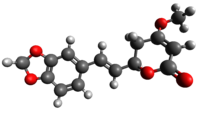Methysticin (original) (raw)
From Wikipedia, the free encyclopedia
Methysticin
 |
|
|---|---|
 |
|
| Names | |
| Preferred IUPAC name (6_R_)-6-[(E)-2-(2_H_-1,3-Benzodioxol-5-yl)ethen-1-yl]-4-methoxy-5,6-dihydro-2_H_-pyran-2-one | |
| Identifiers | |
| CAS Number | 495-85-2  Y Y |
| 3D model (JSmol) | Interactive image |
| ChemSpider | 4444889  N N |
| KEGG | C09952  N N |
| PubChem CID | 5281567 |
| UNII | M832AIJ6HX  Y Y |
| CompTox Dashboard (EPA) | DTXSID5033674 |
InChI InChI=1S/C15H14O5/c1-17-12-7-11(20-15(16)8-12)4-2-10-3-5-13-14(6-10)19-9-18-13/h2-6,8,11H,7,9H2,1H3/b4-2+/t11-/m0/s1  NKey: GTEXBOVBADJOQH-FWEMWIAWSA-N NKey: GTEXBOVBADJOQH-FWEMWIAWSA-N  NInChI=1/C15H14O5/c1-17-12-7-11(20-15(16)8-12)4-2-10-3-5-13-14(6-10)19-9-18-13/h2-6,8,11H,7,9H2,1H3/b4-2+/t11-/m0/s1Key: GTEXBOVBADJOQH-FWEMWIAWBD NInChI=1/C15H14O5/c1-17-12-7-11(20-15(16)8-12)4-2-10-3-5-13-14(6-10)19-9-18-13/h2-6,8,11H,7,9H2,1H3/b4-2+/t11-/m0/s1Key: GTEXBOVBADJOQH-FWEMWIAWBD |
|
| SMILES COC1=CC(=O)O[C@H](C1)/C=C/C2=CC3=C(C=C2)OCO3 | |
| Properties | |
| Chemical formula | C15H14O5 |
| Molar mass | 274.272 g·mol−1 |
Except where otherwise noted, data are given for materials in their standard state (at 25 °C [77 °F], 100 kPa).  N verify (what is N verify (what is  Y Y N ?) Infobox references N ?) Infobox references |
Chemical compound
Methysticin is one of the six major kavalactones found in the kava plant.[1] Research suggests that methysticin and the related compound dihydromethysticin have CYP1A1 inducing effects which may be responsible for their toxicity.[2] Additionally, methysticin has been shown to potentiate GABAA receptor activity, contributing to the overall anxiolytic profile of the kava plant.[3]
Methysticin induces the function of the hepatic enzyme CYP1A1. This enzyme is involved in the toxification of benzo[a]pyrene into (+)-benzo[a]pyrene-7,8-dihydrodiol-9,10-epoxide, a highly carcinogenic substance. Another related compound is dihydromethysticin, which also induces the function of CYP1A1.[2][4][5] No report so far has described enhancement of CYP1A1 expression in animals or humans in vivo from any constituent of kava.[6]
- ^ Malani, Joji (2002-12-03). "Evaluation of the effects of Kava on the Liver" (PDF). Fiji School of Medicine. Archived from the original (PDF) on 2009-03-20. Retrieved 2009-09-04.
- ^ a b Li Y, Mei H, Wu Q, Zhang S, Fang JL, Shi L, Guo L (Dec 2011). "Methysticin and 7,8-dihydromethysticin are two major kavalactones in kava extract to induce CYP1A1". Toxicological Sciences. 124 (2): 388–99. doi:10.1093/toxsci/kfr235. PMC 5736320. PMID 21908763.
- ^ Boonen, G.; Häberlein, H. (1998). "Influence of genuine kavapyrone enantiomers on the GABA-A binding site". Planta Medica. 64 (6): 504–506. doi:10.1055/s-2006-957502. PMID 9776662. S2CID 45511040.
- ^ Beresford, AP (1993). "CYP1A1: friend or foe?". Drug Metab Rev. 25 (4): 503–17. doi:10.3109/03602539308993984. PMID 8313840.
- ^ Uno, S; Dalton TP; Durkenne S; Curran CP (2004). "Oral exposure to benzo[a]pyrene in the mouse: detoxication by inducible cytochrome P450 is more important than metabolic activation". Molecular Pharmacology. 65 (5): 1225–37. doi:10.1124/mol.65.5.1225. PMID 15102951. S2CID 24627183.
- ^ Yamazaki, Yuko; Hashida, Hiroko; Arita, Anna; Hamaguchi, Keiko; Shimura, Fumio (2008). "High dose of commercial products of kava (Piper methysticum) markedly enhanced hepatic cytochrome P450 1A1 mRNA expression with liver enlargement in rats". Food and Chemical Toxicology. 46 (12): 3732–3738. doi:10.1016/j.fct.2008.09.052. ISSN 0278-6915. PMID 18930106.